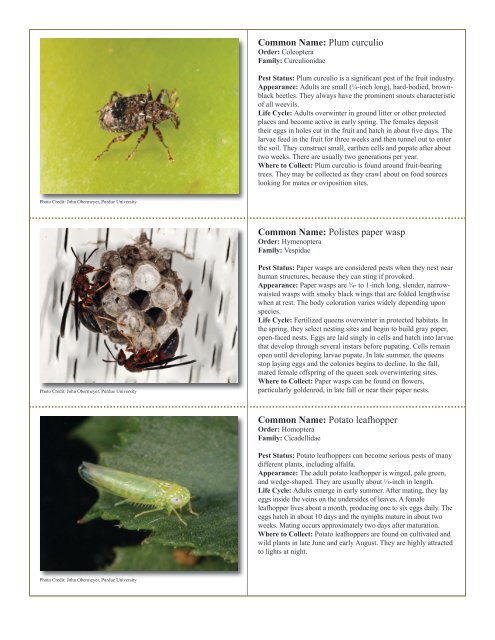to download pdf - Purdue Extension Entomology - Purdue University
to download pdf - Purdue Extension Entomology - Purdue University
to download pdf - Purdue Extension Entomology - Purdue University
Create successful ePaper yourself
Turn your PDF publications into a flip-book with our unique Google optimized e-Paper software.
Common Name: Plum curculio<br />
Order: Coleoptera<br />
Family: Curculionidae<br />
Pest Status: Plum curculio is a significant pest of the fruit industry.<br />
Appearance: Adults are small (¼-inch long), hard-bodied, brownblack<br />
beetles. They always have the prominent snouts characteristic<br />
of all weevils.<br />
Life Cycle: Adults overwinter in ground litter or other protected<br />
places and become active in early spring. The females deposit<br />
their eggs in holes cut in the fruit and hatch in about five days. The<br />
larvae feed in the fruit for three weeks and then tunnel out <strong>to</strong> enter<br />
the soil. They construct small, earthen cells and pupate after about<br />
two weeks. There are usually two generations per year.<br />
Where <strong>to</strong> Collect: Plum curculio is found around fruit-bearing<br />
trees. They may be collected as they crawl about on food sources<br />
looking for mates or oviposition sites.<br />
Pho<strong>to</strong> Credit: John Obermeyer, <strong>Purdue</strong> <strong>University</strong><br />
Common Name: Polistes paper wasp<br />
Order: Hymenoptera<br />
Family: Vespidae<br />
Pho<strong>to</strong> Credit: John Obermeyer, <strong>Purdue</strong> <strong>University</strong><br />
Pest Status: Paper wasps are considered pests when they nest near<br />
human structures, because they can sting if provoked.<br />
Appearance: Paper wasps are ¾- <strong>to</strong> 1-inch long, slender, narrowwaisted<br />
wasps with smoky black wings that are folded lengthwise<br />
when at rest. The body coloration varies widely depending upon<br />
species.<br />
Life Cycle: Fertilized queens overwinter in protected habitats. In<br />
the spring, they select nesting sites and begin <strong>to</strong> build gray paper,<br />
open-faced nests. Eggs are laid singly in cells and hatch in<strong>to</strong> larvae<br />
that develop through several instars before pupating. Cells remain<br />
open until developing larvae pupate. In late summer, the queens<br />
s<strong>to</strong>p laying eggs and the colonies begins <strong>to</strong> decline. In the fall,<br />
mated female offspring of the queen seek overwintering sites.<br />
Where <strong>to</strong> Collect: Paper wasps can be found on flowers,<br />
particularly goldenrod, in late fall or near their paper nests.<br />
Common Name: Pota<strong>to</strong> leafhopper<br />
Order: Homoptera<br />
Family: Cicadellidae<br />
Pest Status: Pota<strong>to</strong> leafhoppers can become serious pests of many<br />
different plants, including alfalfa.<br />
Appearance: The adult pota<strong>to</strong> leafhopper is winged, pale green,<br />
and wedge-shaped. They are usually about 1 ⁄8-inch in length.<br />
Life Cycle: Adults emerge in early summer. After mating, they lay<br />
eggs inside the veins on the undersides of leaves. A female<br />
leafhopper lives about a month, producing one <strong>to</strong> six eggs daily. The<br />
eggs hatch in about 10 days and the nymphs mature in about two<br />
weeks. Mating occurs approximately two days after maturation.<br />
Where <strong>to</strong> Collect: Pota<strong>to</strong> leafhoppers are found on cultivated and<br />
wild plants in late June and early August. They are highly attracted<br />
<strong>to</strong> lights at night.<br />
Pho<strong>to</strong> Credit: John Obermeyer, <strong>Purdue</strong> <strong>University</strong>
















